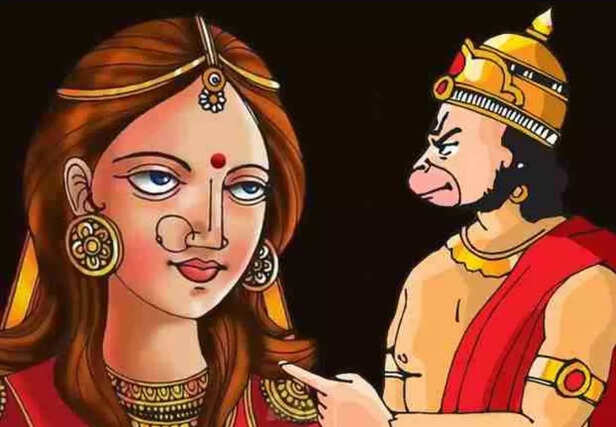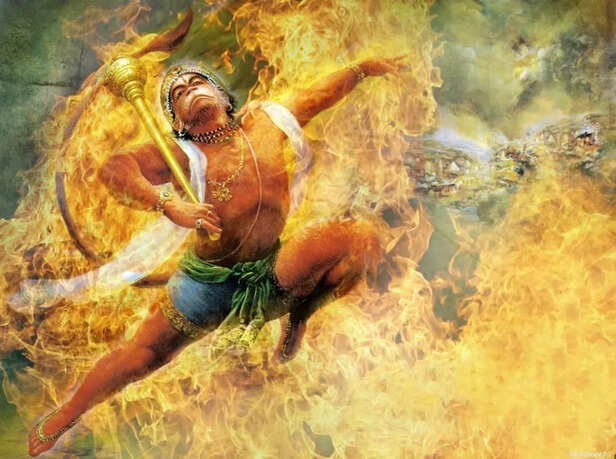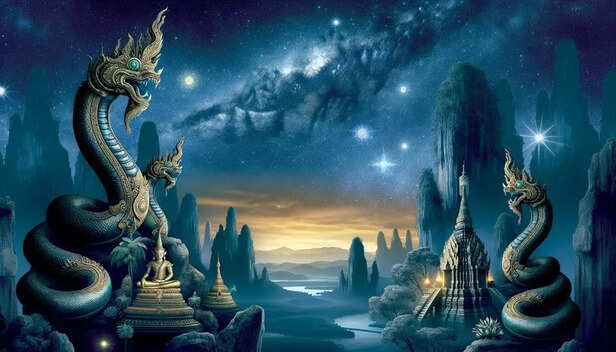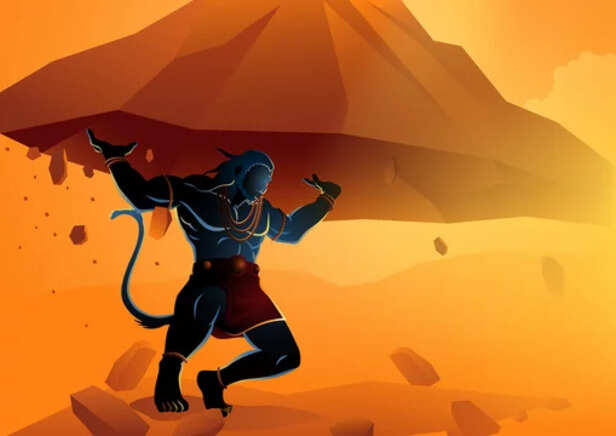Why Did Mandodari Curse Hanuman—Curse That Separated Hanuman from Rama Forever
Ankit Gupta | Apr 28, 2025, 23:22 IST
( Image credit : Timeslife )
Mandodari, the righteous queen of Lanka, curses Hanuman after he tricks her into giving away the magical arrow that leads to Ravana’s death. This curse foretells Hanuman’s future grief at Lord Rama’s departure. The story unfolds with deep spiritual lessons on devotion, destiny, and the eternal Kala Chakra, as Hanuman later journeys to Naga Loka to understand the cosmic cycle of life and loss.
Mandodari's curse on Hanuman is a powerful and poignant moment in the Ramayana, which underscores the deep emotional connections, the tragic nature of the events, and the philosophical underpinnings of duty and loss.
To understand why Mandodari cursed Hanuman, we need to explore the context and significance of the incident. Mandodari, the devoted wife of Ravana, is indeed one of the Panchakanya, revered women whose names are said to purify sins. Despite her marriage to Ravana, Mandodari was a woman of great wisdom and righteousness. She had always advised Ravana against his unjust actions, particularly the abduction of Sita. Her pleas to Ravana to return Sita to her rightful husband, Lord Rama, were ignored, and as a result, Mandodari became a silent witness to the suffering caused by her husband's ego and arrogance.

The particular incident that led to Mandodari’s curse occurs during the climactic phase of the war between Rama's army and Ravana’s forces. After Ravana’s defeat seems inevitable, Vibhishana, Ravana’s brother who had defected to Rama's side, reveals to Lord Rama a crucial detail: Ravana's death can only be ensured with the use of a special magical arrow that is securely kept by Mandodari.
Hanuman, ever devoted to Shri Rama, takes on the guise of a sadhu (a holy man) and enters Ravana’s palace in Lanka. With his intelligence, charm, and devotion, he gains Mandodari's trust. Hanuman manages to steal the magical arrow, which is hidden under Mandodari's bed, and swiftly hands it over to Lord Rama. It is this arrow that Rama uses to strike at Ravana’s navel, where his soul is believed to be concealed, thereby bringing an end to Ravana's tyrannical rule.
However, Mandodari, upon realizing that she has been deceived by Hanuman, is devastated. Not only has she unknowingly facilitated the death of her husband, but she also feels betrayed by someone she believed to be virtuous. She curses Hanuman, saying: "For whom you tricked me, shall be taken away from you one day. Like today, I must live in grief; you too shall live forever in grief."

For Hanuman, the curse has a lasting and significant impact, which unfolds many years later. Hanuman's devotion to Shri Rama is unwavering, and his life is entirely dedicated to serving Rama. Yet, when Rama takes Jala Samadhi (the self-immolation in the river Sarayu), Hanuman is not present by his side. This is a critical moment for Hanuman, as he could not prevent Rama from leaving the earthly realm. In essence, Mandodari’s curse comes to fruition, as Hanuman experiences an existential grief that matches Mandodari’s own sorrow when she lost her husband, Ravana.

The curse manifests itself in a mystical manner. As Hanuman grieves over Rama’s departure, he is sent to Naga Loka (the realm of the Nagas). This mystical event symbolizes both Hanuman's emotional journey and the larger cosmic order at play. In Naga Loka, Hanuman meets Vasuki, the king of the Nagas, who teaches him about the Kala Chakra (the eternal wheel of time) and the cyclical nature of life, death, and rebirth.
This journey to Naga Loka, and the teachings Hanuman receives there, are pivotal in understanding the deeper philosophical layers of the Ramayana. The Kala Chakra explains that even the most profound losses are part of a larger cosmic order. Hanuman’s grief over Rama’s departure is not merely personal but part of the eternal cycle of life and death that governs all beings. His learning in Naga Loka helps him come to terms with the inevitability of change and loss, thus providing a spiritual understanding of his suffering.

Mandodari’s curse on Hanuman is not just a narrative tool but a profound commentary on the nature of duty, grief, and the cyclical nature of time. Hanuman’s life is defined by his devotion to Lord Rama, and this devotion is both his strength and his vulnerability. The curse emphasizes the emotional cost of such unwavering devotion—it is not enough to simply serve; one must also accept the pain and loss that come with love and attachment.
Furthermore, the incident and the curse reflect the idea that suffering is a shared human experience, transcending time, space, and personal circumstances. Mandodari’s curse is a reminder that grief is universal, and even the most exalted beings like Hanuman are not exempt from it. The deep sorrow that Hanuman experiences upon Rama’s departure is not a punishment but a rite of passage—an acknowledgment of the impermanence of the world and the ultimate separation from the divine.
Mandodari’s curse on Hanuman is a key moment in the Ramayana, rich with emotional and philosophical depth. It underscores the inevitability of grief, even for the most devoted beings. Hanuman, the embodiment of selfless devotion and strength, is not immune to the sorrows of life. The curse, however, also serves as a catalyst for Hanuman’s deeper spiritual understanding, which he gains through his mystical journey to Naga Loka. Through the teachings of Vasuki and the revelation of the Kala Chakra, Hanuman comes to understand the cyclical nature of existence and the importance of accepting both love and loss as part of the cosmic order.
In the end, Mandodari’s curse is a reflection of the interconnectedness of all beings and the shared experience of suffering. It is through this shared experience that Hanuman, even in his grief, transcends his own sorrow and continues to be a symbol of strength, devotion, and wisdom for all who seek his blessings.
To understand why Mandodari cursed Hanuman, we need to explore the context and significance of the incident. Mandodari, the devoted wife of Ravana, is indeed one of the Panchakanya, revered women whose names are said to purify sins. Despite her marriage to Ravana, Mandodari was a woman of great wisdom and righteousness. She had always advised Ravana against his unjust actions, particularly the abduction of Sita. Her pleas to Ravana to return Sita to her rightful husband, Lord Rama, were ignored, and as a result, Mandodari became a silent witness to the suffering caused by her husband's ego and arrogance.
The Incident Leading to the Curse

Image Credit: Pixabay
( Image credit : Timeslife )
The particular incident that led to Mandodari’s curse occurs during the climactic phase of the war between Rama's army and Ravana’s forces. After Ravana’s defeat seems inevitable, Vibhishana, Ravana’s brother who had defected to Rama's side, reveals to Lord Rama a crucial detail: Ravana's death can only be ensured with the use of a special magical arrow that is securely kept by Mandodari.
Hanuman, ever devoted to Shri Rama, takes on the guise of a sadhu (a holy man) and enters Ravana’s palace in Lanka. With his intelligence, charm, and devotion, he gains Mandodari's trust. Hanuman manages to steal the magical arrow, which is hidden under Mandodari's bed, and swiftly hands it over to Lord Rama. It is this arrow that Rama uses to strike at Ravana’s navel, where his soul is believed to be concealed, thereby bringing an end to Ravana's tyrannical rule.
However, Mandodari, upon realizing that she has been deceived by Hanuman, is devastated. Not only has she unknowingly facilitated the death of her husband, but she also feels betrayed by someone she believed to be virtuous. She curses Hanuman, saying: "For whom you tricked me, shall be taken away from you one day. Like today, I must live in grief; you too shall live forever in grief."
The Curse’s Impact on Hanuman

Image Credit: Pixel
( Image credit : Timeslife )
- Mandodari’s curse is poignant in its depth and sorrow. She speaks from a place of deep emotional turmoil—her loyalty to her husband, Ravana, and her helplessness in preventing his downfall. In cursing Hanuman, she effectively condemns him to experience the same grief and loss that she has endured. The curse is not only about vengeance but also an expression of the shared sorrow that comes from love, loyalty, and the inevitable consequences of duty.
For Hanuman, the curse has a lasting and significant impact, which unfolds many years later. Hanuman's devotion to Shri Rama is unwavering, and his life is entirely dedicated to serving Rama. Yet, when Rama takes Jala Samadhi (the self-immolation in the river Sarayu), Hanuman is not present by his side. This is a critical moment for Hanuman, as he could not prevent Rama from leaving the earthly realm. In essence, Mandodari’s curse comes to fruition, as Hanuman experiences an existential grief that matches Mandodari’s own sorrow when she lost her husband, Ravana.
The Mystical Incident and Hanuman's Journey to Naga Loka

Image Credit: Freepik
( Image credit : Timeslife )
The curse manifests itself in a mystical manner. As Hanuman grieves over Rama’s departure, he is sent to Naga Loka (the realm of the Nagas). This mystical event symbolizes both Hanuman's emotional journey and the larger cosmic order at play. In Naga Loka, Hanuman meets Vasuki, the king of the Nagas, who teaches him about the Kala Chakra (the eternal wheel of time) and the cyclical nature of life, death, and rebirth.
This journey to Naga Loka, and the teachings Hanuman receives there, are pivotal in understanding the deeper philosophical layers of the Ramayana. The Kala Chakra explains that even the most profound losses are part of a larger cosmic order. Hanuman’s grief over Rama’s departure is not merely personal but part of the eternal cycle of life and death that governs all beings. His learning in Naga Loka helps him come to terms with the inevitability of change and loss, thus providing a spiritual understanding of his suffering.
The Philosophical Implications

Image Credit: Pixabay
( Image credit : Timeslife )
Mandodari’s curse on Hanuman is not just a narrative tool but a profound commentary on the nature of duty, grief, and the cyclical nature of time. Hanuman’s life is defined by his devotion to Lord Rama, and this devotion is both his strength and his vulnerability. The curse emphasizes the emotional cost of such unwavering devotion—it is not enough to simply serve; one must also accept the pain and loss that come with love and attachment.
Furthermore, the incident and the curse reflect the idea that suffering is a shared human experience, transcending time, space, and personal circumstances. Mandodari’s curse is a reminder that grief is universal, and even the most exalted beings like Hanuman are not exempt from it. The deep sorrow that Hanuman experiences upon Rama’s departure is not a punishment but a rite of passage—an acknowledgment of the impermanence of the world and the ultimate separation from the divine.
An Inevitable
In the end, Mandodari’s curse is a reflection of the interconnectedness of all beings and the shared experience of suffering. It is through this shared experience that Hanuman, even in his grief, transcends his own sorrow and continues to be a symbol of strength, devotion, and wisdom for all who seek his blessings.
